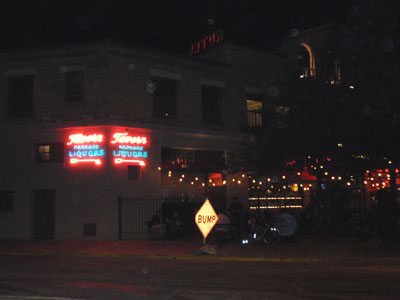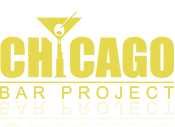“I’ll be damned.” – John Dillinger on being arrested shortly after a fire at the Hotel Congress
“I’ll be damned.” – Randy Kohl (intrepid reviewer) after finding a hotel bar he actually liked
 On January 22, 1934, a fire started somewhere in the basement of the Hotel Congress. It quickly spread and engulfed the third floor, sending hotel guests running into the streets. Among the displaced were two men who anxiously pleaded with firefighters to retrieve their luggage. Once recovered (and searched), the bags were found to contain three Thompson sub-machine guns, two Winchester rifles, five bullet-proof vests and $25,000 in cash. A few hours later, Russell Clark, Charles Makley, Harry Pierpoint, and their ringleader, John Dillinger, were arrested in what was the culmination of a nation-wide manhunt. What was for Dillinger and his crew nothing more than being in the wrong place at the wrong time became a part of history.
On January 22, 1934, a fire started somewhere in the basement of the Hotel Congress. It quickly spread and engulfed the third floor, sending hotel guests running into the streets. Among the displaced were two men who anxiously pleaded with firefighters to retrieve their luggage. Once recovered (and searched), the bags were found to contain three Thompson sub-machine guns, two Winchester rifles, five bullet-proof vests and $25,000 in cash. A few hours later, Russell Clark, Charles Makley, Harry Pierpoint, and their ringleader, John Dillinger, were arrested in what was the culmination of a nation-wide manhunt. What was for Dillinger and his crew nothing more than being in the wrong place at the wrong time became a part of history.
The Hotel Congress, originally opened in 1919, has seen its share of history though it is far from being a historic relic. In its current incarnation, The Hotel Congress is a vibrant nightlife spot in a rapidly rejuvenating section of downtown Tucson. Part budget-minded boutique hotel, part diner, part tavern and part nightclub, the Hotel Congress offers a range of entertainment options for savvy locals and curious tourists, and that’s not even including the ghosts.
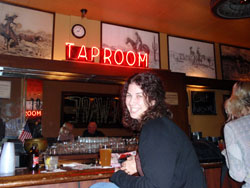 Though largely remodeled, the exterior and interior of the Hotel Congress retain a nostalgic look that spans the 1920s-50s. The lobby is a study in southwestern art-deco design. The lobby, which was completely hand-painted by a traveling artist in the late 80s, comes complete with an extremely well-stocked bar and an array of news clippings about the hotel’s history. Leading off from the lobby is a second bar and adjoining stage area, which operates as the Club Congress. As the name implies, Club Congress offers entertainment and dancing seven nights a week. It is also booked for private parties, which proved quite interesting when I arrived on the night of the local roller derby awards. (Someone please explain the correlation between roller derby and Rock-a-Billy.)
Though largely remodeled, the exterior and interior of the Hotel Congress retain a nostalgic look that spans the 1920s-50s. The lobby is a study in southwestern art-deco design. The lobby, which was completely hand-painted by a traveling artist in the late 80s, comes complete with an extremely well-stocked bar and an array of news clippings about the hotel’s history. Leading off from the lobby is a second bar and adjoining stage area, which operates as the Club Congress. As the name implies, Club Congress offers entertainment and dancing seven nights a week. It is also booked for private parties, which proved quite interesting when I arrived on the night of the local roller derby awards. (Someone please explain the correlation between roller derby and Rock-a-Billy.)
The heart and soul of the Hotel Congress, however, is the Tap Room. The Tap Room sits self-contained from the rest of the hotel, a tiny time-capsule consisting of a worn L-shaped bar, a handful of booths, a vintage Wurlitzer and a volume of history. This is where Dillinger passed the time while laying low. In the 1930s and 40s, famed Rodeo artist Pete Martinez called the Tap Room home. A series of his original drawings and etchings, which the artist donated to his favorite bar, still hang from the walls almost seventy years later. In the 1970s it was not uncommon to find Hollywood legend Lee Marvin enjoying his favorite drink among the regulars.
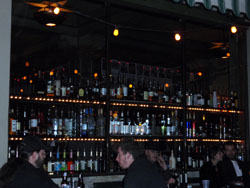 And the current clientele is no less varied or colorful. This is not a hangout for the college crowd. Expect to find those of post-graduate age and beyond from all backgrounds. The man on the stool to my left turned out to be John McCain. Not the John McCain, but a John McCain from Phoenix, whose unfortunate name was the source for some entertaining stories.
And the current clientele is no less varied or colorful. This is not a hangout for the college crowd. Expect to find those of post-graduate age and beyond from all backgrounds. The man on the stool to my left turned out to be John McCain. Not the John McCain, but a John McCain from Phoenix, whose unfortunate name was the source for some entertaining stories.
Then there are the reports of ghosts. A man in an old-fashioned gray suit is sometimes seen peering from the second-storey windows of unoccupied rooms. Room 242 is known as the Suicide Room, after a woman took her life following a stand-off with police. A bullet hole in the closet still bears witness to the events of that night. Guests have reported hearing strange noises and seeing the apparition of a woman in the hallway and the room’s bathroom. The scent of phantom roses can sometimes be detected along the lobby stairwell. And for several years, hotel staff has been finding butter knives scattered around the second floor. Vince, a resident at the Congress for 36 years, had been known for stealing the knives, until his death in 2001. Personally, I witnessed nothing spooky, though some of the roller-derby girls were alarmingly pale.
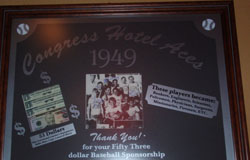 Even the exterior sidewalk, which predates the Congress, tells a story. In the outdoor cafe that fronts the Tap Room and lobby bars, you can still find sections of pavement embedded with thick multi-colored bubbles of glass. The glass allows light to filter down to a series of long-closed pedestrian tunnels. According to legend, and seconded by a veteran bartender, the tunnels were used to ferry the mostly Chinese migrant railroad workers to and from their job sites. Though the workers were employed to help build the city’s infrastructure, they were forbidden to walk the city’s streets or mingle with “polite society.”
Even the exterior sidewalk, which predates the Congress, tells a story. In the outdoor cafe that fronts the Tap Room and lobby bars, you can still find sections of pavement embedded with thick multi-colored bubbles of glass. The glass allows light to filter down to a series of long-closed pedestrian tunnels. According to legend, and seconded by a veteran bartender, the tunnels were used to ferry the mostly Chinese migrant railroad workers to and from their job sites. Though the workers were employed to help build the city’s infrastructure, they were forbidden to walk the city’s streets or mingle with “polite society.”
Now that the White Sox have moved their spring training home to Glendale, there is one less reason for wintering Chicagoans to visit Tucson. However, any visit to the area would be lacking if it did not include a stop at the Hotel Congress and its much admired Tap Room. Its history of gangsters and ghosts, combined with a lively atmosphere and unpretentious crowd, easily makes the Hotel Congress my favorite Tucson haunt.
